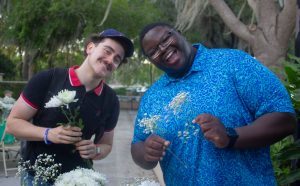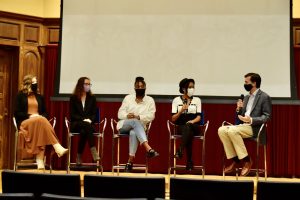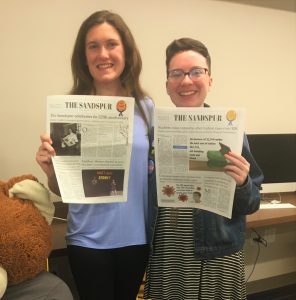
On a Wednesday night in February, Rachel Feil stands at a whiteboard in room 232 of David Lawrence Hall, tapping a red Expo marker on her chin as she studies what she’s scribbled on the surface.
“I don’t know,” she tells the man standing next to her. “I don’t think that works. We need more information.”
Behind her, five groups of four to six University of Pittsburgh students on laptops are laser-focused on their research. Some skim online news articles while others bounce theories off each other, fingers flying over the keyboard when it seems that somebody’s voiced a thought worth recording.
They’re trying to answer a question —not to an essay prompt or a physics problem, but to a puzzle left unsolved for more than 20 years: Who murdered Stephanie Coyle?
The students, most of whom are planning a career in fields such as law, law enforcement or forensics, are members of Pitt’s Conquering Cold Cases Club.
“Our main focus is trying to help the victims’ loved ones find some answers for the questions they have, so that they can finally have some closure,” sophomore club President Alex Morgan said.
It sounds like the setup for an amateur homicide investigation show, and it might be. The club has attracted attention since seniors Nicole Coons and Hannah Eisenhart founded it in 2015. A film crew even spent some time in February with the members to see if their work was worthy of a TV show — the club hasn’t heard back yet.
“The club’s still a work in progress, but it’s growing rapidly and is way more structured than when we first started it last year,” said Coons, an administration of justice and political science major.
Coons got the idea when she saw a flyer at a country club in her hometown in July 2014 asking for help locating Kortnee Stouffer, who was 21 when she disappeared two years prior. After talking with an attendant at the club and an old friend of Stouffer’s, she was inspired to enlist Pitt students to help track similar cases.
“Police departments always have a lot going on, and they can’t usually focus on just one specific case,” Coons said. “I thought that getting a bunch of Pitt students with a passion for criminal justice to hone in on a couple of cases in particular would be a great way to give back to the community and help some people out.”
The club now has roughly 30 members, all of whom skip around between examining the Coyle case, the Stouffer case and the 2005 murder of 94-year-old Beaver County resident Anna Rocknick. Students interested in participating in CCC have to sign a privacy contract and undergo an interview process with club leaders to make prove they’re serious.
“It’s not all about having fun or sharpening their detective skills,” Eisenhart said. “It’s about seeking justice.”
Pennsylvania has one of the highest clearance rates for solving murders and homicides, according to Project Cold Case — a national project aimed at tracking the number of unsolved murders nationwide — but still, more than 20 percent go unsolved.
Stephanie Coyle’s case is one that has gone without justice or answers for more than two decades, stumping investigators in western Pennsylvania.
Police found the 74-year-old woman on the floor of her bedroom apartment the morning of July 16, 1993, in the small town of Arnold, Pennsylvania. She died from a stab wound to her throat. A design was carved into her back after death, and her corpse had been sexually assaulted.
CCC has been working on this case since September, after finding it with a Google search for “local cold cases.” The web is full of reports on the unsolved Coyle case — her grisly death rocked the Alle Kiski suburb where she lived. Her long-suffering son has since posted hefty rewards for anyone with information that could crack the case.
This is how CCC typically operates — tracking down information and related names through online news articles, and then using social media to find possible witnesses, family members and involved law enforcement.
This is the one edge they have over the police, said junior Zach Bruce.
“We’re a lot more tech-savvy than them, probably because we’re younger,” Bruce, an economics and business major, said. “They may have more information than we do, but we’ve got Google and more time.”
CCC has interviewed an EMT who responded to Coyle’s murder, one of her children and the Arnold chief of police.
“It’s pretty chilling,” Feil, an undeclared first-year student, said. “This isn’t CSI. This is real stuff that’s happened to real people.”
Asking the right questions
Feil eventually sketched out the layout of Coyle’s house and the surrounding area on the whiteboard that Wednesday, recreating the scene based on research she did using Google Maps and news clippings from the time of the murder.
Feil is trying to determine a possible entrance to the house with what little information she’s been able to glean from the internet. While she studies the board, her peers pick each others’ brains about what they know — and still don’t know — about the Coyle case.
“We need to figure out if this guy has left the area or not.”
“Since it was in the neck, she was probably unable to move. That paralyzes the spine.”
Law enforcement in general can be tight-lipped about sharing information with the group, and witnesses and family members are often skeptical about what a bunch of college kids can do.
“If it’s a family member of the victim, it can get pretty emotional, and you have to be tactful and patient,” Bruce said. “Also, you have to be prepared to get conflicting information. The policeman you talk to has probably seen several autopsy pictures in his lifetime. He or she may not correctly remember the one you’re asking about.”
Luckily, the club has retired Pittsburgh police commander and adjunct law professor Ronald Freeman to help. He agreed to serve as CCC’s adviser after Coons, a former student of his, approached him in 2014. He’s connected the club with former colleagues and friends — including a handwriting expert and a medical examiner — from his 37 years with the city police.
“This club is an excellent opportunity for law students still studying in the classroom to get some hands-on experience,” Freeman said. “[The students are] invested and they’re focused in the cases they’re working on.”
It was Freeman who put the students in contact with William Webber, Arnold’s former chief of police. He responded to Coyle’s death as a patrolman and has kept up with it even after his retirement in 2015.
“It’s kept me up at night sometimes,” Webber said of the case. “This isn’t something I want to have to take to my grave unsolved.”
Facing Facts
The Wednesday after Feil sketched Coyle’s house onto the whiteboard, CCC’s room was devoid of the usual animated chatter about suspects and speculations. Instead, only Webber’s deep voice echoed as he clicked through a slideshow of evidence and case files.
A graying man with a confident bearing, he rattled off details about the case without glancing at his Power Point, recounting what happened the night of Coyle’s death for the 100th time. The students stared unflinchingly at the screen, even when grisly autopsy pictures slid by.
“The reason I’m showing you this,” Webber told the students, “is because you might see something I don’t. I’d really like to find out who did this, so that I can punch a guy in the face.”
Almost as soon the last slide ends, members started firing off questions.
“Did it look like any article of clothing had been ripped off?”
“Which suspect stands out the most to you?”
“Was there an area where there was a majority of blood, or was it all just drops?”
This is the kind of unbridled access that makes the club one of a kind, members say.
“We toured a medical examiner’s place once in my criminalistics class, but we’ve never done anything like speak with a cop about the details of a case,” said Nihita Manhem, a junior neuroscience major, after Webber’s visit. “We get to see stuff even the media isn’t allowed to see.”
Three weeks later — as March rolls in — the club moves on to its next step in the Coyle case, researching names on a suspect list from Webber. The students go through the usual routine of breaking off into groups, and immediately start combing the internet for contact information.
“I found a guy with that name in his late 60s who lives in New Jersey as a preacher!”
“Yeah, and I found one with the same name that’s white and proudly German.”
“Dude, this one hasn’t updated his profile since 2012.”
Eisenhart said working with loved ones of victims is the hardest but most rewarding part about trying to solve cold cases. Besides Coyle’s son, Dan, the club has also spoken with the people who had close relationships with the victims in the Stouffer and Rodnick cases.
“It really puts it into perspective. This is what I might be dealing with someday, considering what I want to do,” she said. “It’s heartbreaking, but it’s good to know that the work I’m doing is giving them hope.”
By mid-March, CCC hasn’t solved Coyle’s case, but they’ve gotten some — currently confidential — new leads and plan on sticking with the investigation. Mark Safarik, a former FBI profiler whose job is to psychologically analyze a criminal’s behavior in the hopes of catching them, has even agreed to profile the Coyle case for the club.
Megan Hixon, an undeclared first-year student thinking about going into forensics, is hopeful that Safarik will help CCC members narrow down the information they’ve gathered so far.
With any luck, they might be able to finally bring a sliver of peace to Coyle’s family.
“Who knows, maybe 30-some college students are going to be able to spot something new,” she said.
By Janine Faust















Be First to Comment